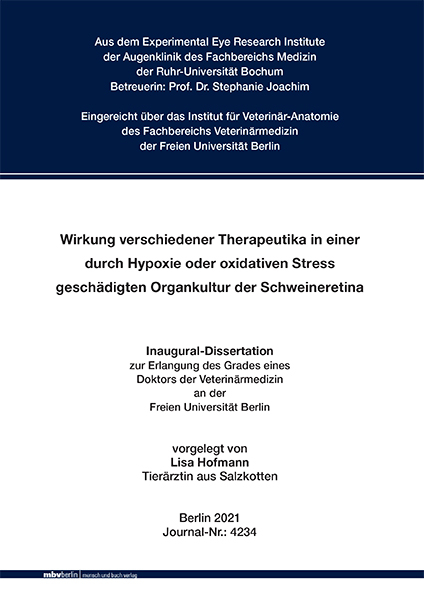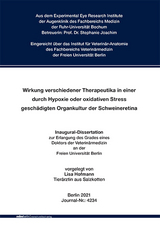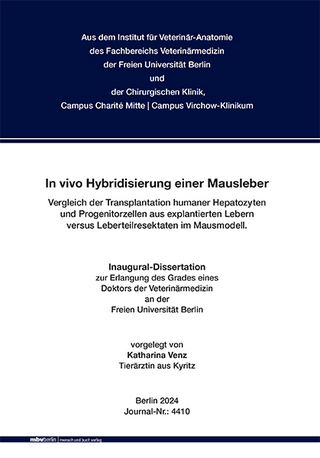Wirkung verschiedener Therapeutika in einer durch Hypoxie oder oxidativen Stress geschädigten Organkultur der Schweineretina
Seiten
2022
|
1. Aufl.
Mensch & Buch (Verlag)
978-3-96729-149-0 (ISBN)
Mensch & Buch (Verlag)
978-3-96729-149-0 (ISBN)
- Keine Verlagsinformationen verfügbar
- Artikel merken
"Effect of different therapeutics in an organ culture of porcine rentina damaged by hypoxia or oxidative stress"
Hypoxia and oxidative stress are pathomechanisms that are involved in several retinal diseases, such as glaucoma. Hypoxia can be chemically induced by cobalt chloride (CoCl2), whereas hydrogen peroxide (H2O2) can cause oxidative stress.
Based on two established models of cultured porcine retinae (Hurst 2017; Kuehn 2017), the potential neuroprotective effect of the iNOS-inhibitor was tested in this dissertation.
In another study the neuroprotection by the antioxidant coenzyme q10 (CoQ10) was examined.
The effect of the iNOS-inhibitor was investigated using both models, in which either hypoxic processes were mimicked by CoCl2 (300 μM), or triggered by oxidative stress induced by 300 μM H2O2. The effect of CoQ10 was only examined in the model of oxidative stress. The treatment with 500 μM of the iNOS-inhibitor 1400W lasted 72 h, that with CoQ10 48 h.
Retinal ganglion cells were immunohistochemically labeled with anti-RBPMS antibody, then counted using ImageJ and finally analyzed post hoc using a one-factorial ANOVA followed by a Tuckey test.
The use of the iNOS-inhibitor in the hypoxia model was able to produce a significant protection of the retinal ganglion cells after four and eight days. CoCl2 resulted in a significant loss of retinal ganglion cells at four and eight days in comparison to the control retinas.
In a second project, the retinal ganglion cells were significantly protected from oxidative stress by the iNOS-inhibitor. H2O2 resulted in a significant loss of retinal ganglion cells after four and eight days of cultivation, whereas the iNOS-inhibitor protected the retinal ganglion cells from oxidative stress after four and eight days.
In comparison, the use of 100 and 300 μM CoQ10 did not lead to any significant protection of the retinal ganglion cells.
Hypoxia and oxidative stress induced by CoCl2 and H2O2 result in a significant loss of retinal ganglion cells. Both degeneration models serve as suitable models to investigate potential neuroprotective agents. As shown in the iNOS-inhibitor studies, the iNOS-inhibitor 1400W protects the retinal ganglion cells against both pathomechanisms.
For further studies, more retinal cells should be investigated to get a better understanding of the exact mechanism of the iNOS-inhibitor.
CoQ10 as a possible neuroprotectant should also be further explored. Hypoxie und oxidativer Stress sind wichtige Pathomechanismen verschiedener retinaler Erkrankungen, wie z.B. dem Glaukom. Eine Hypoxie kann durch Kobaltchlorid (CoCl2) chemisch induziert werden, wohingegen Wasserstoffperoxid (H2O2) oxidativen Stress auslösen kann.
Basierend auf zwei etablierten Modellen kultivierter Schweineretinae (Hurst 2017; Kuehn 2017), wurde in dieser Dissertation die potentiell neuroprotektive Wirkung des iNOS-Inhibitors 1400W getestet. In einer weiteren Studie wurde die Neuroprotektion durch das Antioxidans Coenzym Q10 (CoQ10) untersucht.
Die Wirkung des iNOS-Inhibitors wurde in beiden Modellen untersucht, bei denen entweder durch CoCl2 (300 μM) hypoxische Prozesse nachgeahmt wurden, oder durch 300 μM H2O2 oxidativer Stress ausgelöst wurde. Die Wirkung von CoQ10 wurde nur im Modell des oxidativen Stresses untersucht. Die Behandlung mit dem iNOS-Inhibitor dauerte insgesamt 72 h, die mit CoQ10 48 h.
Die retinalen Ganglienzellen wurden mittels anti-RBPMS Antikörper immunhistochemisch markiert, anschließend via ImageJ ausgezählt und schließlich mittels einer einfaktoriellen ANOVA mit anschließendem Tukey Test post hoc analysiert.
Der Einsatz des iNOS-Inhibitors im Hypoxiemodell konnte sowohl nach vier als auch nach acht Tagen eine signifikante Protektion der retinalen Ganglienzellen hervorrufen. CoCl2 hingegen führte zu einem signifikanten Verlust der retinalen Ganglienzellen, sowohl nach vier als auch nach acht Tagen im Vergleich zu den Kontroll-Retinae.
Im zweiten Projekt kam es zu einer signifikanten Protektion der retinalen Ganglienzellen vor oxidativem Stress durch den iNOS-Inhibitor. H2O2 führte zu einem signifikanten Verlust der retinalen Ganglienzellen nach vier und acht Tagen Kultivierung, wohingegen der iNOS-Inhibitor nach vier und acht Tagen die retinalen Ganglienzellen vor oxidativem Stress schützte.
Im Vergleich dazu führte der Einsatz von 100, als auch von 300 μM CoQ10 zu keinem signifikanten Schutz der retinalen Ganglienzellen.
Hypoxie und oxidativer Stress, induziert durch CoCl2 und H2O2, führen zu einem signifikanten Verlust der retinalen Ganglienzellen. Beide Degenerationsmodelle scheinen geeignet zu sein, um potentielle Neuroprotektiva zu testen. Wie in den iNOS-Inhibitor-Studien gezeigt werden konnte, schützte der iNOS-Inhibitor 1400W die retinalen Ganglienzellen vor Hypoxie und oxidativem Stress.
In weiteren Studien sollten daher die Effekte des iNOS-Inhibitors auf andere retinale Zellen untersucht werden, um den exakten Wirkungsmechanismus besser verstehen zu können.
Auch CoQ10 als mögliches Neuroprotektivum sollte weitergehend erforscht werden.
Hypoxia and oxidative stress are pathomechanisms that are involved in several retinal diseases, such as glaucoma. Hypoxia can be chemically induced by cobalt chloride (CoCl2), whereas hydrogen peroxide (H2O2) can cause oxidative stress.
Based on two established models of cultured porcine retinae (Hurst 2017; Kuehn 2017), the potential neuroprotective effect of the iNOS-inhibitor was tested in this dissertation.
In another study the neuroprotection by the antioxidant coenzyme q10 (CoQ10) was examined.
The effect of the iNOS-inhibitor was investigated using both models, in which either hypoxic processes were mimicked by CoCl2 (300 μM), or triggered by oxidative stress induced by 300 μM H2O2. The effect of CoQ10 was only examined in the model of oxidative stress. The treatment with 500 μM of the iNOS-inhibitor 1400W lasted 72 h, that with CoQ10 48 h.
Retinal ganglion cells were immunohistochemically labeled with anti-RBPMS antibody, then counted using ImageJ and finally analyzed post hoc using a one-factorial ANOVA followed by a Tuckey test.
The use of the iNOS-inhibitor in the hypoxia model was able to produce a significant protection of the retinal ganglion cells after four and eight days. CoCl2 resulted in a significant loss of retinal ganglion cells at four and eight days in comparison to the control retinas.
In a second project, the retinal ganglion cells were significantly protected from oxidative stress by the iNOS-inhibitor. H2O2 resulted in a significant loss of retinal ganglion cells after four and eight days of cultivation, whereas the iNOS-inhibitor protected the retinal ganglion cells from oxidative stress after four and eight days.
In comparison, the use of 100 and 300 μM CoQ10 did not lead to any significant protection of the retinal ganglion cells.
Hypoxia and oxidative stress induced by CoCl2 and H2O2 result in a significant loss of retinal ganglion cells. Both degeneration models serve as suitable models to investigate potential neuroprotective agents. As shown in the iNOS-inhibitor studies, the iNOS-inhibitor 1400W protects the retinal ganglion cells against both pathomechanisms.
For further studies, more retinal cells should be investigated to get a better understanding of the exact mechanism of the iNOS-inhibitor.
CoQ10 as a possible neuroprotectant should also be further explored. Hypoxie und oxidativer Stress sind wichtige Pathomechanismen verschiedener retinaler Erkrankungen, wie z.B. dem Glaukom. Eine Hypoxie kann durch Kobaltchlorid (CoCl2) chemisch induziert werden, wohingegen Wasserstoffperoxid (H2O2) oxidativen Stress auslösen kann.
Basierend auf zwei etablierten Modellen kultivierter Schweineretinae (Hurst 2017; Kuehn 2017), wurde in dieser Dissertation die potentiell neuroprotektive Wirkung des iNOS-Inhibitors 1400W getestet. In einer weiteren Studie wurde die Neuroprotektion durch das Antioxidans Coenzym Q10 (CoQ10) untersucht.
Die Wirkung des iNOS-Inhibitors wurde in beiden Modellen untersucht, bei denen entweder durch CoCl2 (300 μM) hypoxische Prozesse nachgeahmt wurden, oder durch 300 μM H2O2 oxidativer Stress ausgelöst wurde. Die Wirkung von CoQ10 wurde nur im Modell des oxidativen Stresses untersucht. Die Behandlung mit dem iNOS-Inhibitor dauerte insgesamt 72 h, die mit CoQ10 48 h.
Die retinalen Ganglienzellen wurden mittels anti-RBPMS Antikörper immunhistochemisch markiert, anschließend via ImageJ ausgezählt und schließlich mittels einer einfaktoriellen ANOVA mit anschließendem Tukey Test post hoc analysiert.
Der Einsatz des iNOS-Inhibitors im Hypoxiemodell konnte sowohl nach vier als auch nach acht Tagen eine signifikante Protektion der retinalen Ganglienzellen hervorrufen. CoCl2 hingegen führte zu einem signifikanten Verlust der retinalen Ganglienzellen, sowohl nach vier als auch nach acht Tagen im Vergleich zu den Kontroll-Retinae.
Im zweiten Projekt kam es zu einer signifikanten Protektion der retinalen Ganglienzellen vor oxidativem Stress durch den iNOS-Inhibitor. H2O2 führte zu einem signifikanten Verlust der retinalen Ganglienzellen nach vier und acht Tagen Kultivierung, wohingegen der iNOS-Inhibitor nach vier und acht Tagen die retinalen Ganglienzellen vor oxidativem Stress schützte.
Im Vergleich dazu führte der Einsatz von 100, als auch von 300 μM CoQ10 zu keinem signifikanten Schutz der retinalen Ganglienzellen.
Hypoxie und oxidativer Stress, induziert durch CoCl2 und H2O2, führen zu einem signifikanten Verlust der retinalen Ganglienzellen. Beide Degenerationsmodelle scheinen geeignet zu sein, um potentielle Neuroprotektiva zu testen. Wie in den iNOS-Inhibitor-Studien gezeigt werden konnte, schützte der iNOS-Inhibitor 1400W die retinalen Ganglienzellen vor Hypoxie und oxidativem Stress.
In weiteren Studien sollten daher die Effekte des iNOS-Inhibitors auf andere retinale Zellen untersucht werden, um den exakten Wirkungsmechanismus besser verstehen zu können.
Auch CoQ10 als mögliches Neuroprotektivum sollte weitergehend erforscht werden.
| Erscheinungsdatum | 17.02.2022 |
|---|---|
| Verlagsort | Berlin |
| Sprache | deutsch |
| Maße | 148 x 210 mm |
| Gewicht | 490 g |
| Themenwelt | Veterinärmedizin ► Allgemein |
| Veterinärmedizin ► Vorklinik | |
| Schlagworte | Animal model • experimental eye research • Ganglia • Ganglien • geschädigte Organkultur • Hypoxia • Hypoxie • Immunhistochemie • immunohistochemistry • Netzhaut • Oxidation • Oxidativer Stress • Pigs • Porcine retina • porkeretina • retina • Retinopathie • Retinopathy • Schweine • Schweineretina • Stress • Therapeutika • Tiermodell |
| ISBN-10 | 3-96729-149-9 / 3967291499 |
| ISBN-13 | 978-3-96729-149-0 / 9783967291490 |
| Zustand | Neuware |
| Informationen gemäß Produktsicherheitsverordnung (GPSR) | |
| Haben Sie eine Frage zum Produkt? |
Mehr entdecken
aus dem Bereich
aus dem Bereich
Buch | Softcover (2025)
Mensch & Buch (Verlag)
CHF 69,85


